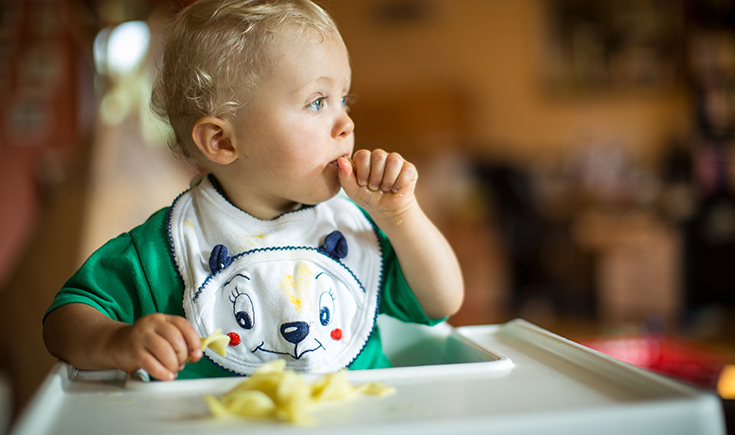

Finger food should not be started before 6 months of age, says Kate Save, Dietitian, Exercise Physiologist and Diabetes Educator from Be Fit Food.
“Your baby should be able to sit up and hold their head up independently,” she says.
The baby should start out by eating rice baby cereal, pureed vegetables and fruit, and pureed meats, in combination with breast milk or formula.
Solids can be given prior to breast or formula feeds. You can also try mixed infant cereals that contain oats, barley, rye, rice and so forth. The texture of fruit and cooked vegetables can progress from puree to mash with some lumps.
From 6-8 months:
Ms Save says babies will usually have to close their hand around a piece of food to hold it; so long strips of food work best at this age. Foods too small can cause frustration.
Try:
● Teething milk rusks
● Cooked sticks of vegetables (pumpkin, carrot, sweet potato, potato)
● Soft cooked florets of cauliflower and broccoli
● Soft pieces of fruits (cooked pear and apple, ripe banana)
● Well cooked pasta shapes
● Strips of cooked meat or chicken (soft)
“They can even use their hands for mashed foods – prepare for mess!”
Foods to avoid/ be careful with:
● Whole nuts or large pieces of nuts (choking hazard)
● Popcorn (choking hazard)
● Whole fruits with stones (choking hazard)
● Round fruits (grapes, cherry tomatoes etc.)
● Meat and fish containing bones and/or gristle (choking hazard)
● Processed foods (high in sodium and sugar)
9-11 months:
By 9 months of age, Ms Save says most babies have developed fine motor skills, with small precise movements enabling them to pick up small pieces of food and feed themselves. They will then develop further and be able to take hold of food in a pincer grasp (between forefinger and thumb).
Encourage finger food as this helps your baby to develop independent, healthy eating habits. Though, you still need to be helping by spoon-feeding infant cereal and other important dietary requirements.
Try:
● White or wholemeal bread or toast.
● Rice cakes and crackers
● Include all vegetables, raw or chopped rather than mashed.
● Include fruit and remove tough skins and large seeds.
● Remove all skin, gristle and bones from meat.
● Introduce dairy such as yoghurt and cheese.
● Pieces of boiled egg
Note: Milk should not be provided as a drink until 12 months
12-16 months:
By 12 months of age, your baby should be self-feeding with assistance as necessary, says Ms Save. They can continue to eat similar foods as 11 months of age, but you can introduce a greater variety of textures, flavours and variety of ‘new’ foods. This could include herbs and seasoning, and combination of foods creating small meals. They are transitioning to eating more closely with the ‘family meal’. Your baby can also start to drink full cream cows milk.
● Porridge
● Scrambled eggs and avocado on toast
● Roast chicken and vegetables
● Spaghetti Bolognese
● Sandwiches
18-24 months:
At this stage toddlers are joining in with family meals and are using a spoon, Ms Save says. They will be eating foods from all five food groups and will have tried many different flavours, textures and types of food. This will also be the time they learn to sip through a straw and drink from a cup. As they are more independent, they are also developing food preferences. This is when fussy eating can commence.
● Offer a good balance of finger food.
● Serve meals in small portions (large portions can be overwhelming).
● Provide family foods and include them in family mealtime.
● Continue exposure to a variety of healthy foods.
● Try not to prepare a ‘special’ separate meal for your toddler.
● Try not to give too much to drink, particularly milk, between meals or just before a meal – this can be filling and cause them to reject food.
● They can be having a similar meal structure to normal family eating- 3 meals and 2-3 snacks per day.























